Why you can trust Tom's Hardware
As a mainstream card priced at $329, we're kicking things off at the lower end of the resolution spectrum with our 1080p medium and 1080p ultra results. We'll have the ultra charts first and the medium charts second in each of the galleries.
With 16GB of memory, the RX 7600 XT shouldn't have any issues with 1080p ultra, except in games that require extra computational work — like games with heavy ray tracing or even so-called path tracing. Rasterization games meanwhile should easily break 60 fps even at maxed out settings.
AMD RX 7600 XT 1080p Overall Performance
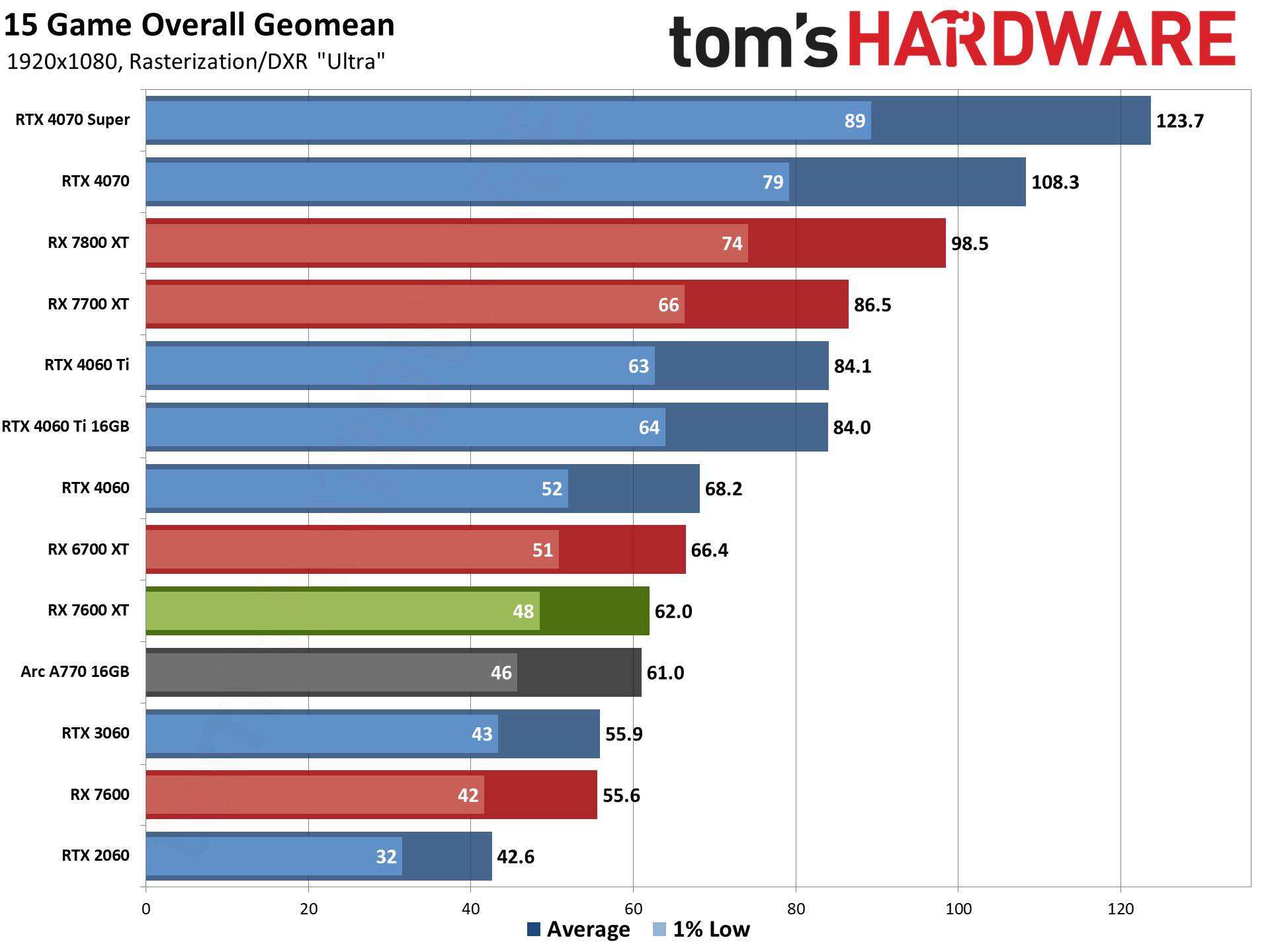

Things kick off with a pattern that will repeat throughout our test suite. Compared to the vanilla RX 7600, the RX 7600 XT offers a modest 10% bump in performance — which drops to just 5% at medium settings. That's enough to push it ahead of the Arc A770 16GB, but it still can't quite catch the RTX 4060. Of course, that's because we're factoring in ray tracing games with the overall score.
The more problematic aspect is the RX 6700 XT, which is 7% faster than the new card. Perhaps that's not enough to make it the better purchase option, today, but like we've seen with so many of the other RDNA 3 RX 7000-series GPUs, it does mean this new card doesn't clearly offer a better value than the previous generation. There will be some exceptions in our test suite, but for gaming, the RX 6700 XT with 12GB of memory is universally faster.
The 7600 XT does easily surpass previous generation parts like the RTX 2060 and 3060, but it would be shockingly bad if it didn't, and it's still only 11–12 percent faster than the two years old Nvidia GPU. If you're looking for a good upgrade from the 3060, you'd really need to plan on spending quite a bit more than $329.
AMD RX 7600 XT 1080p Rasterization Performance
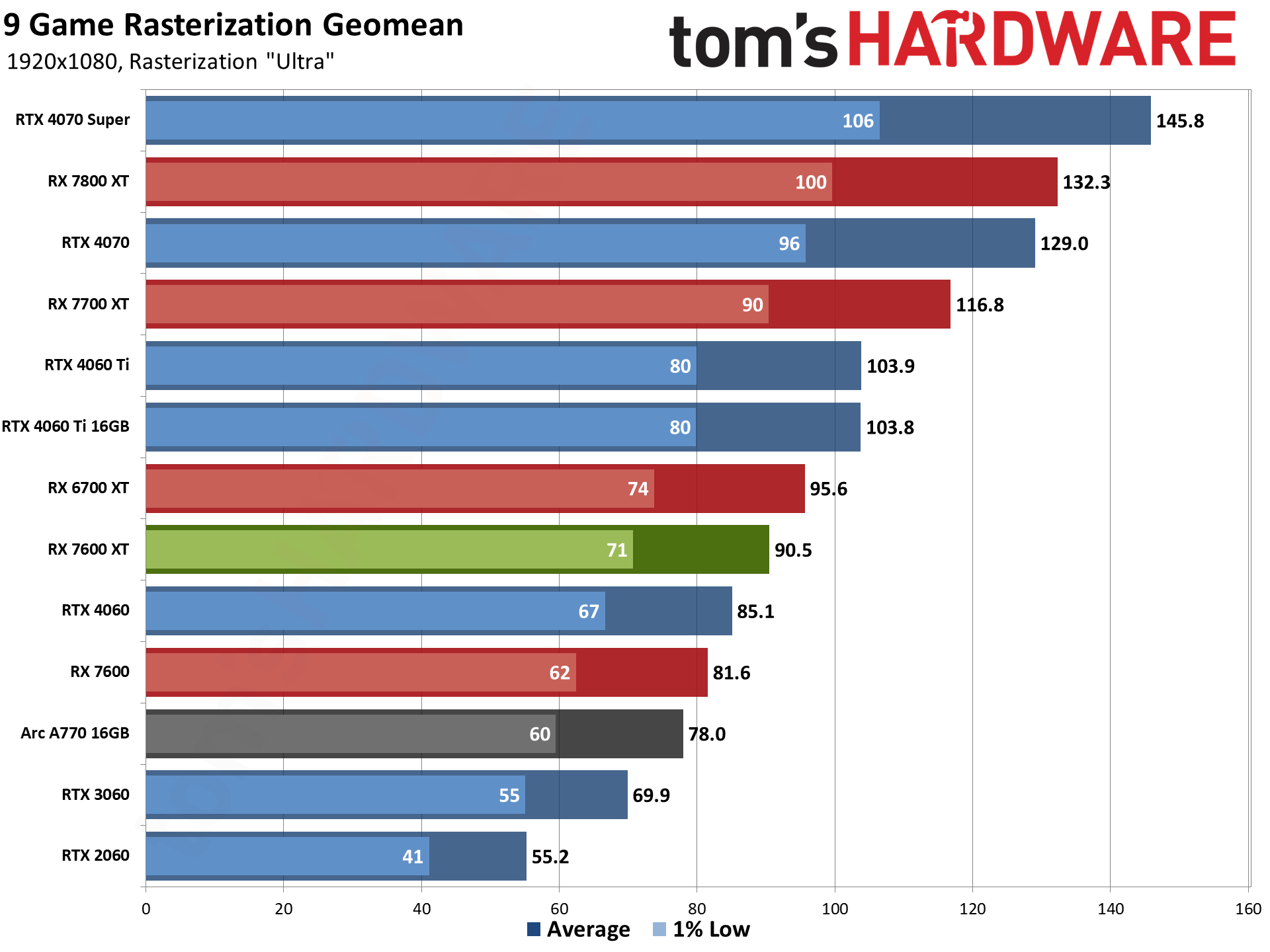

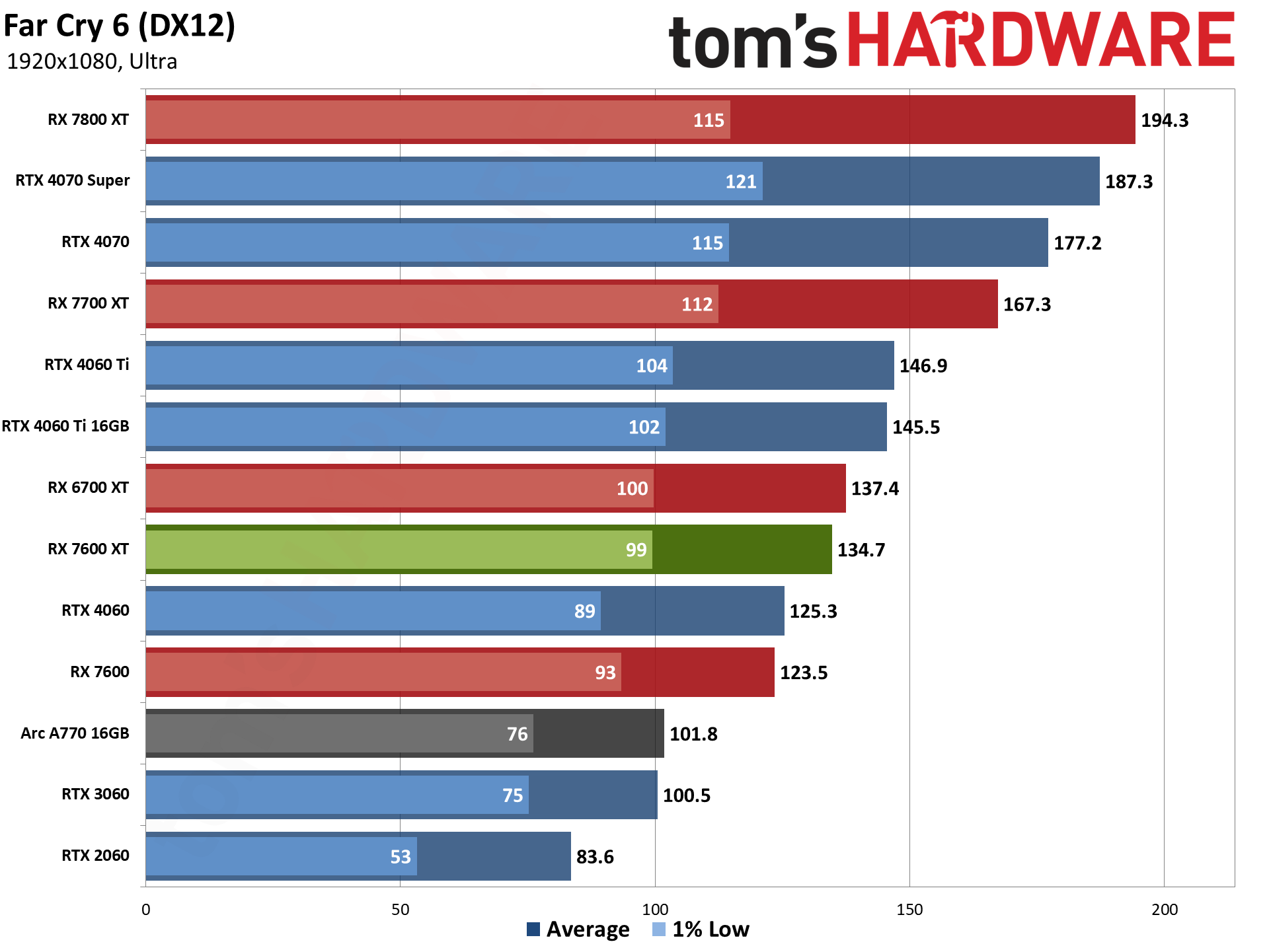
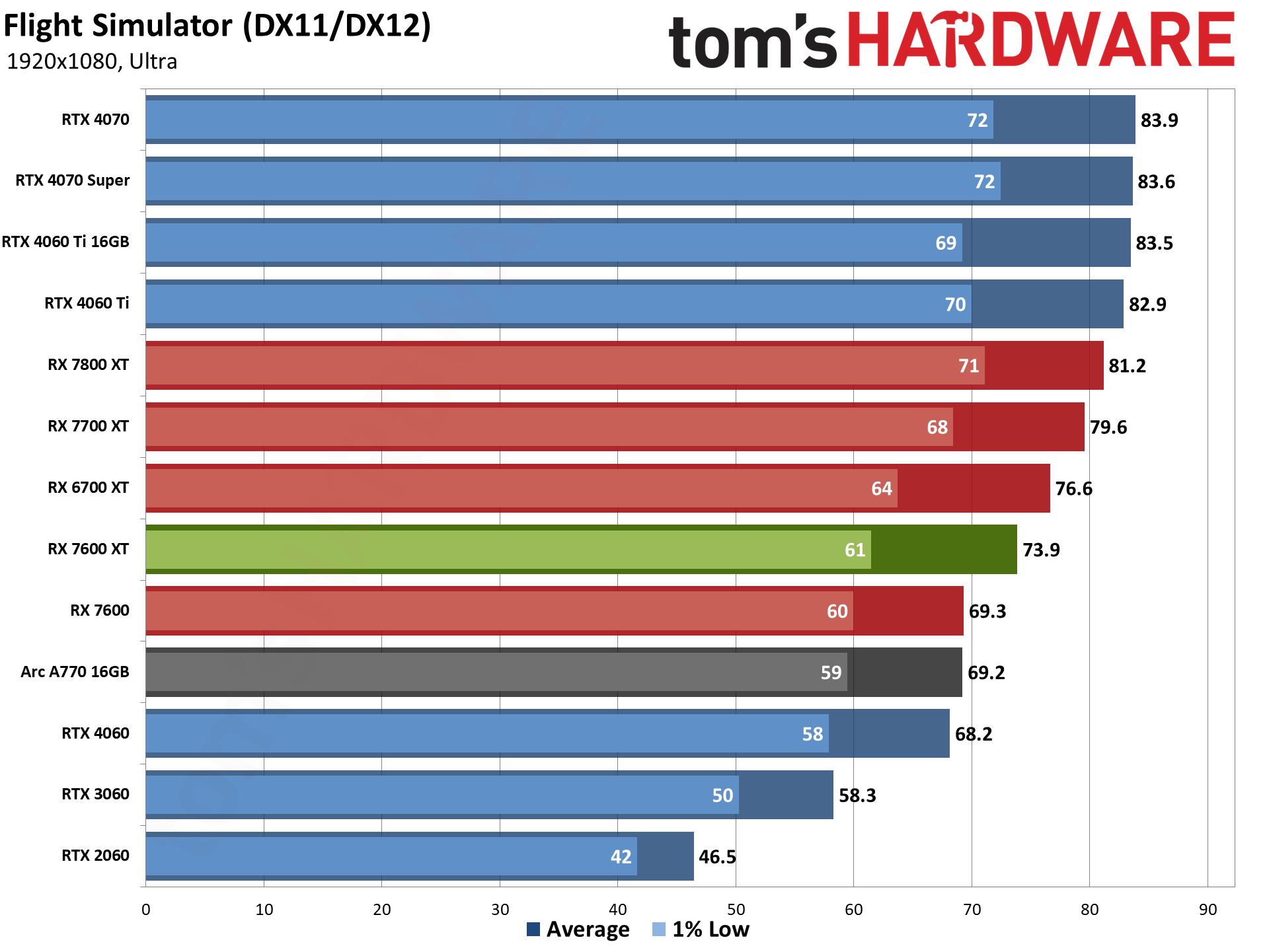
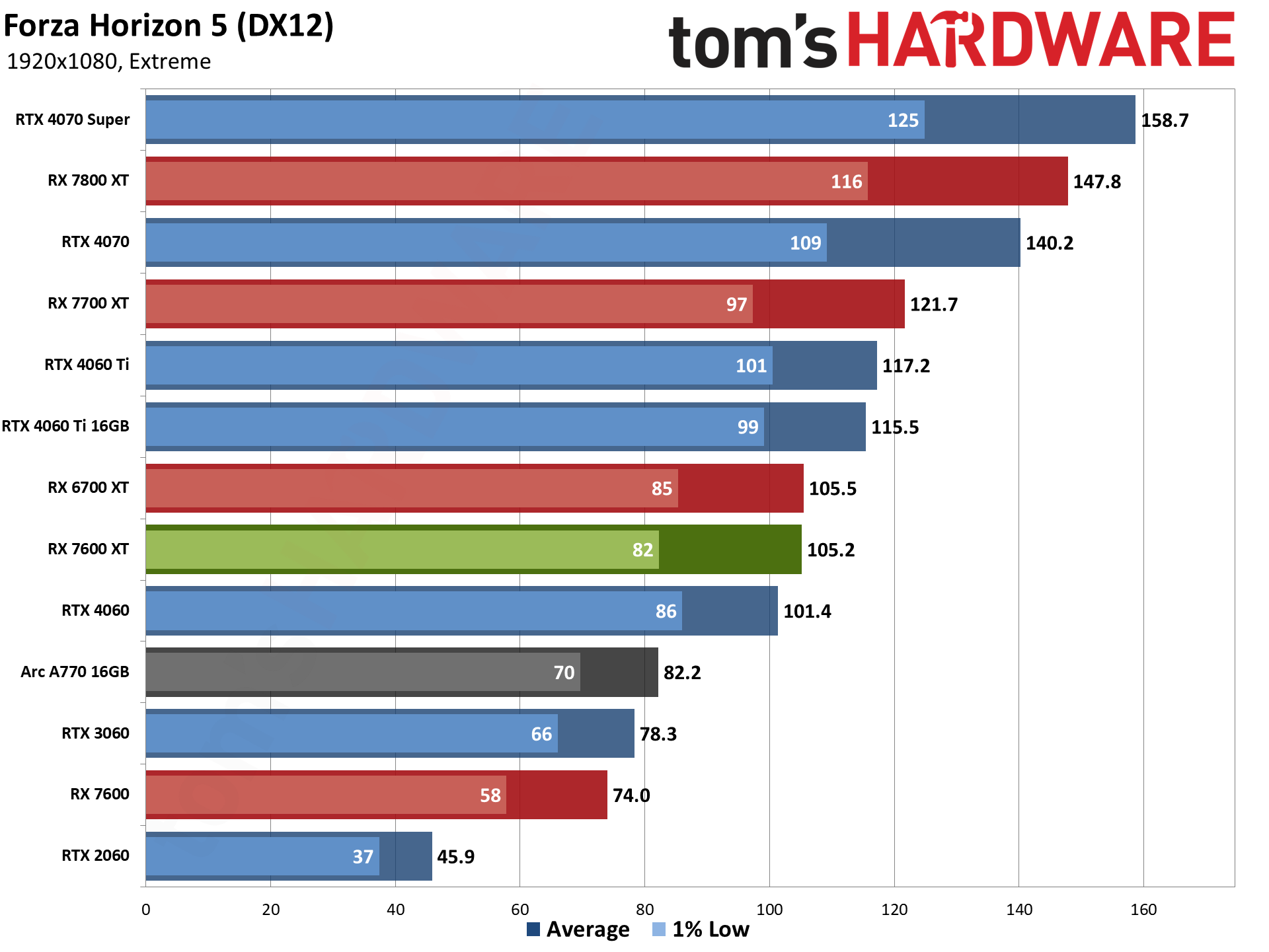
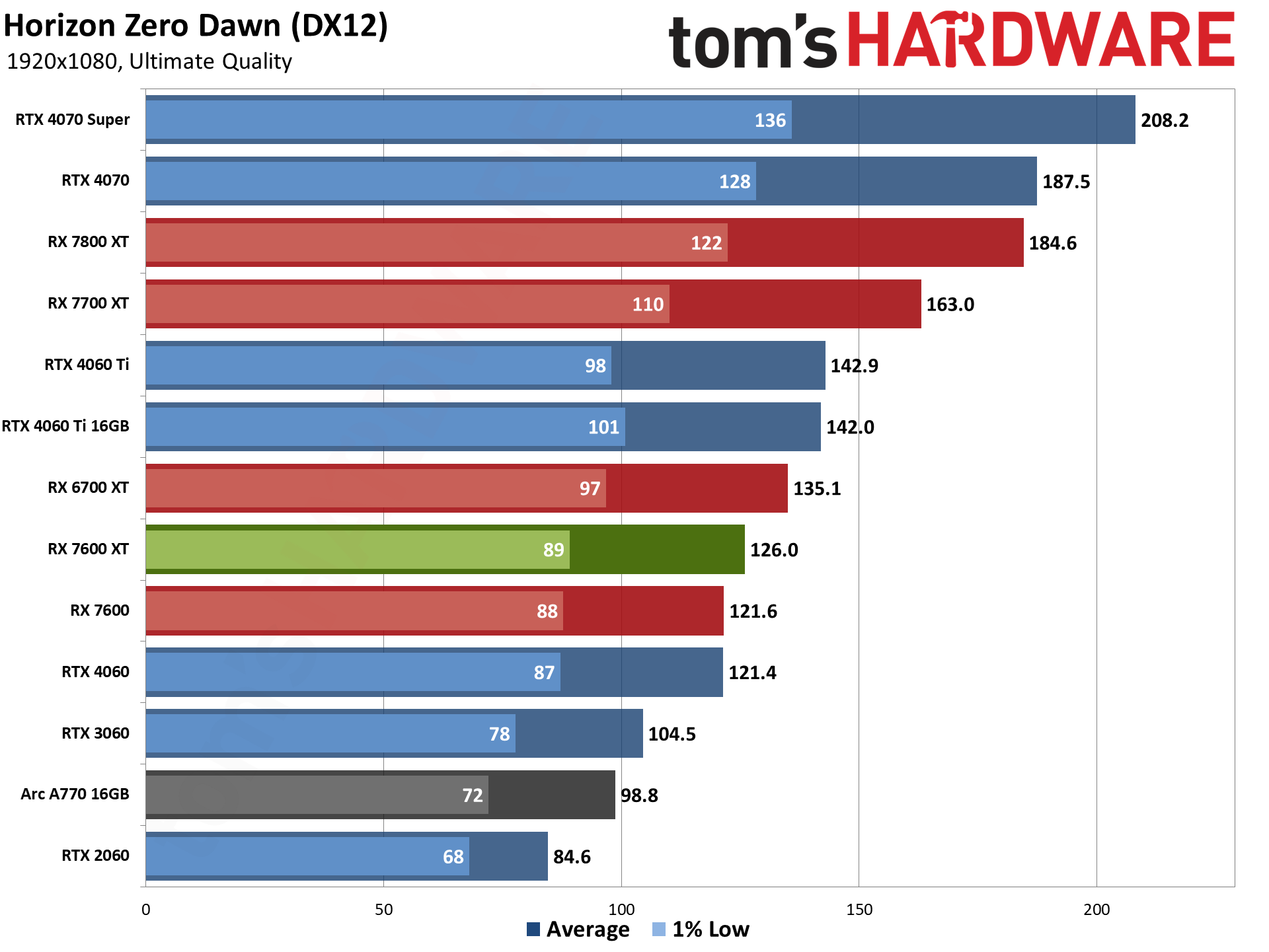

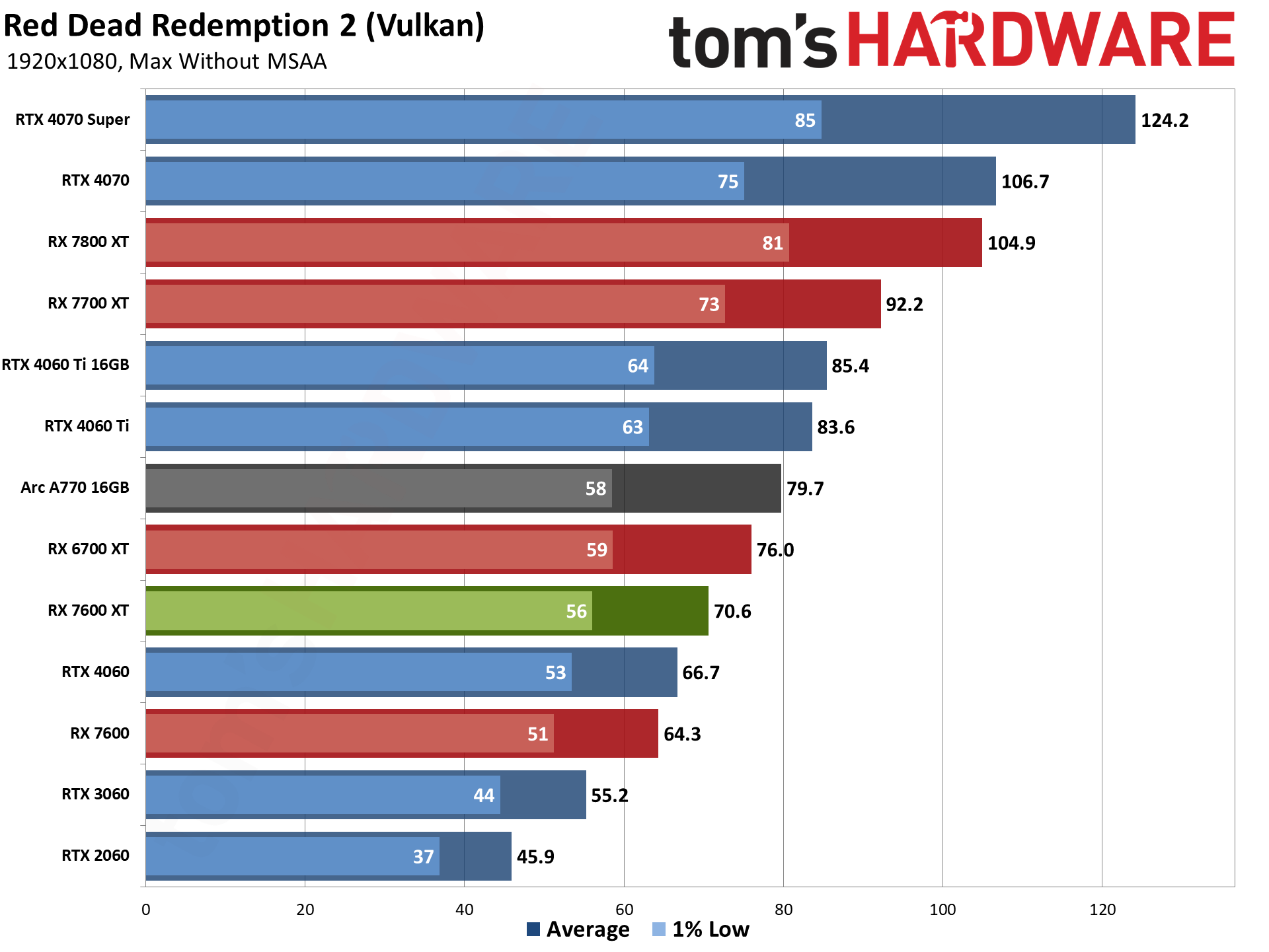

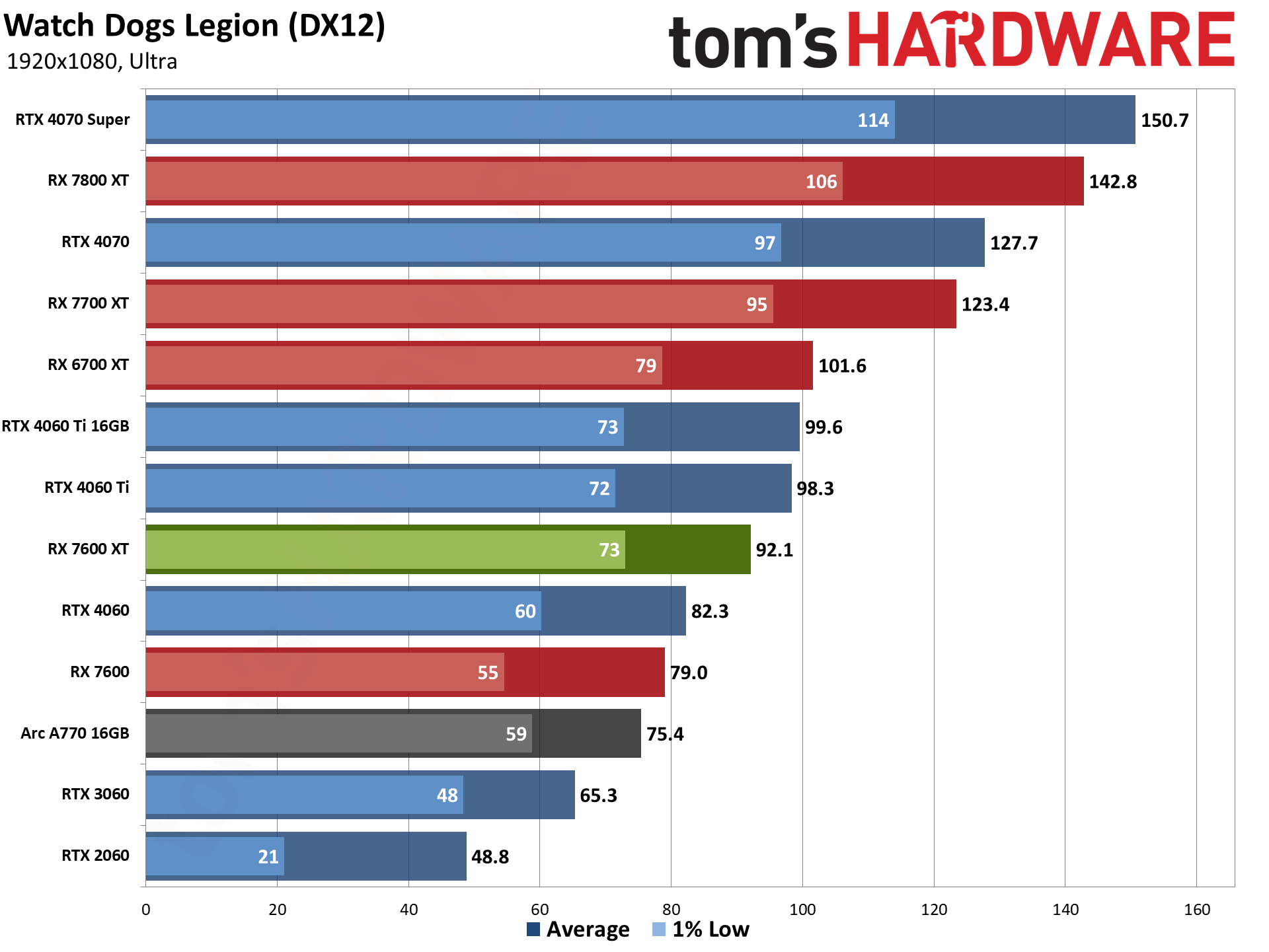

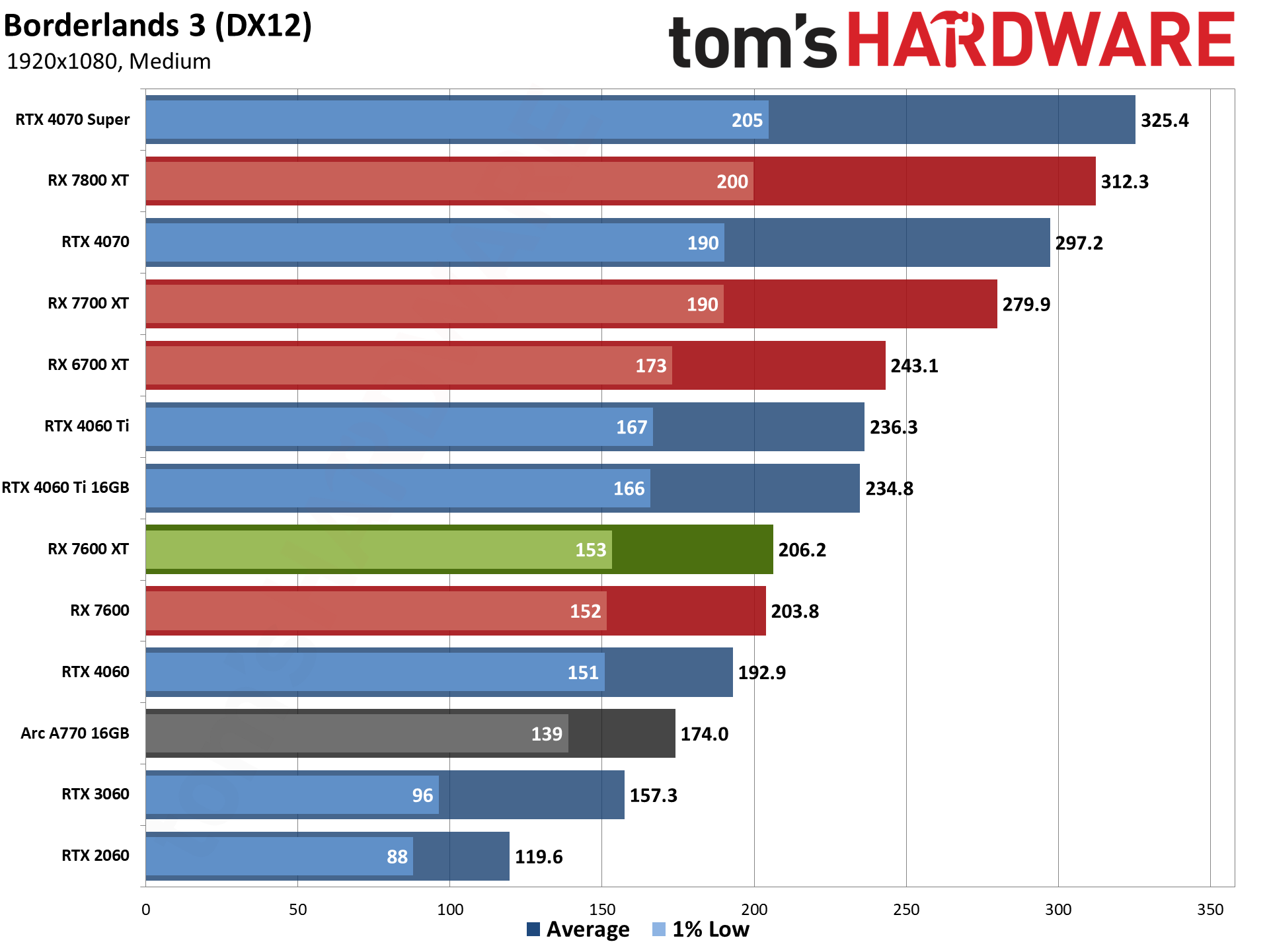


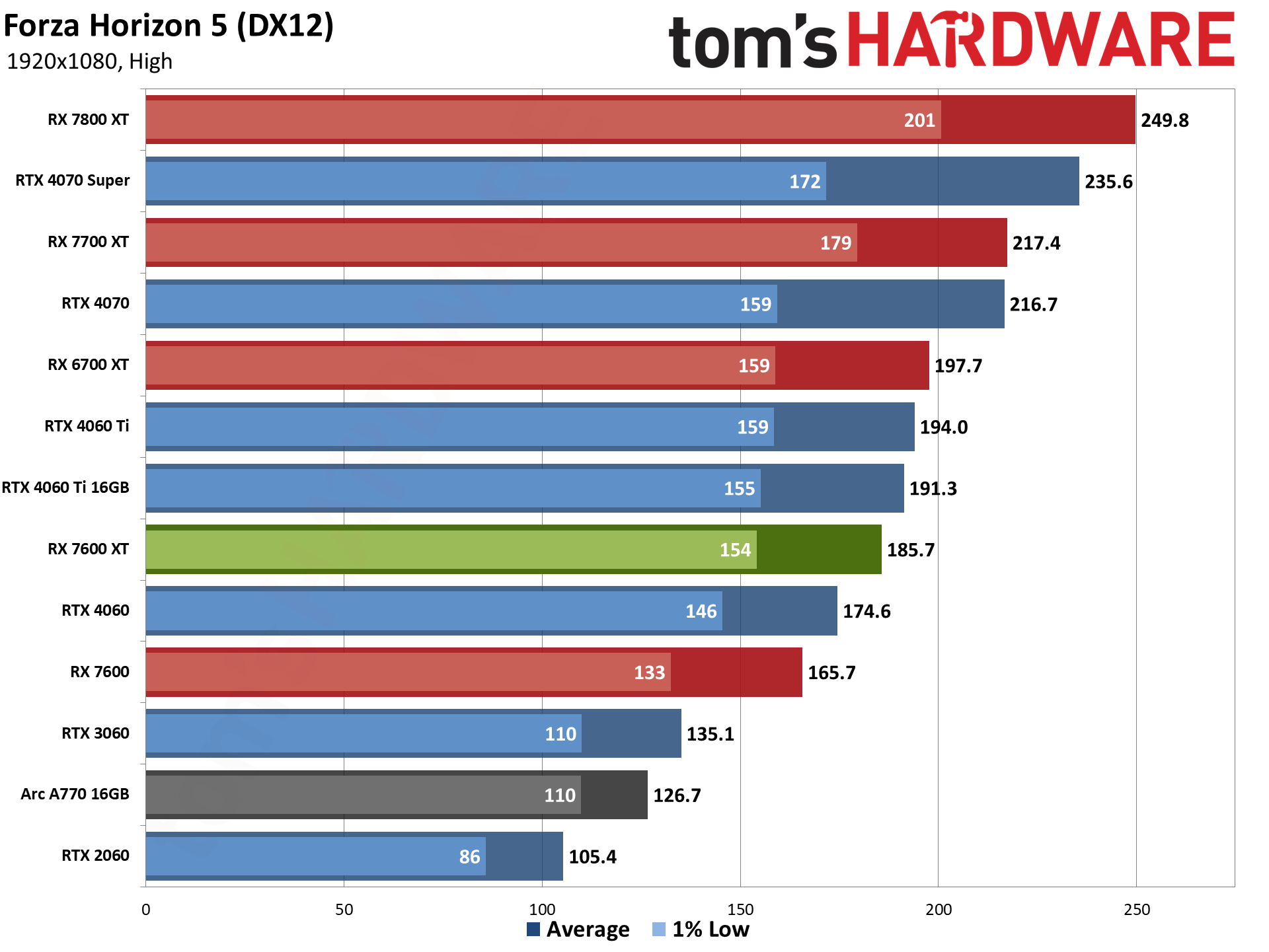
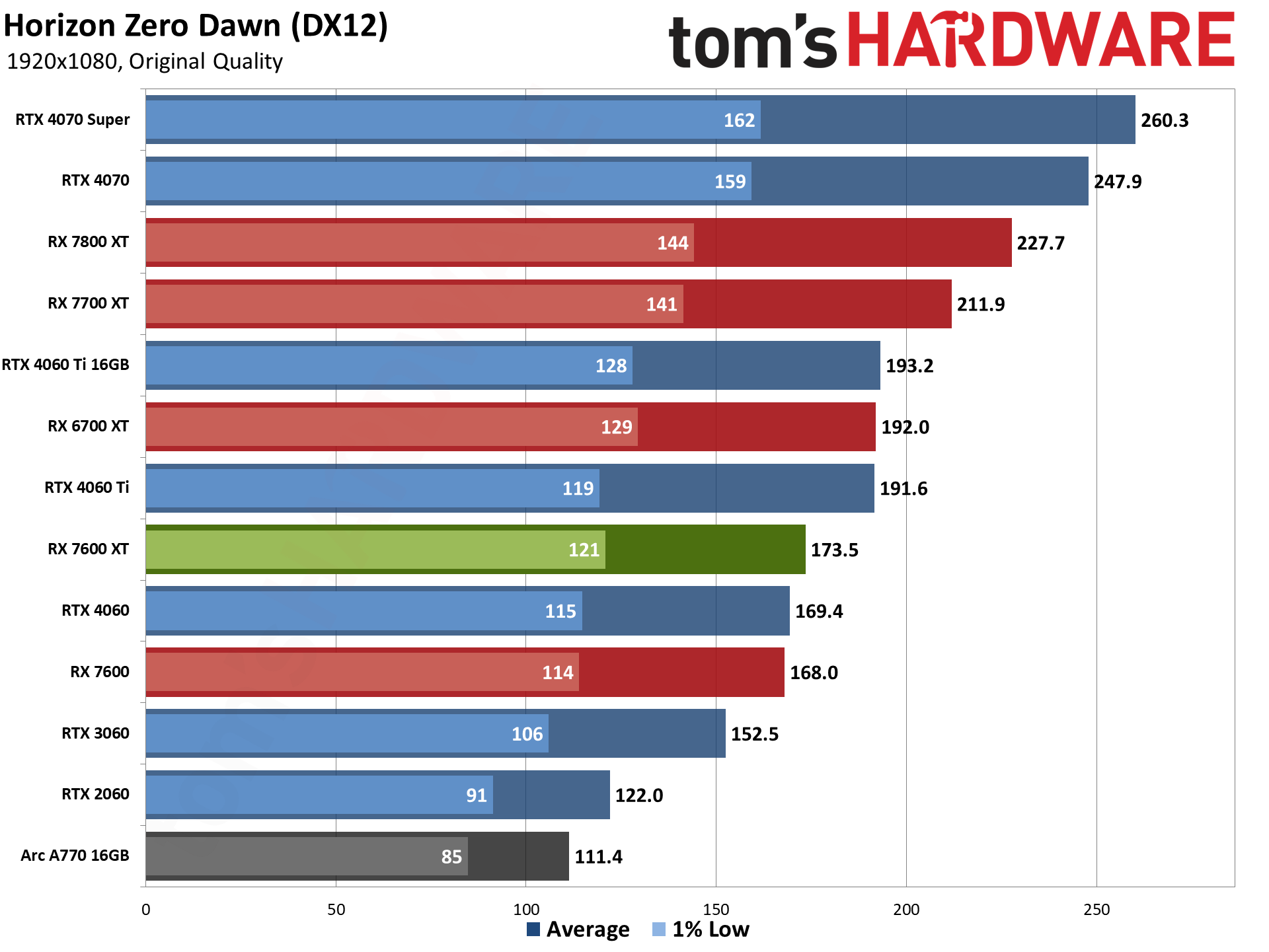
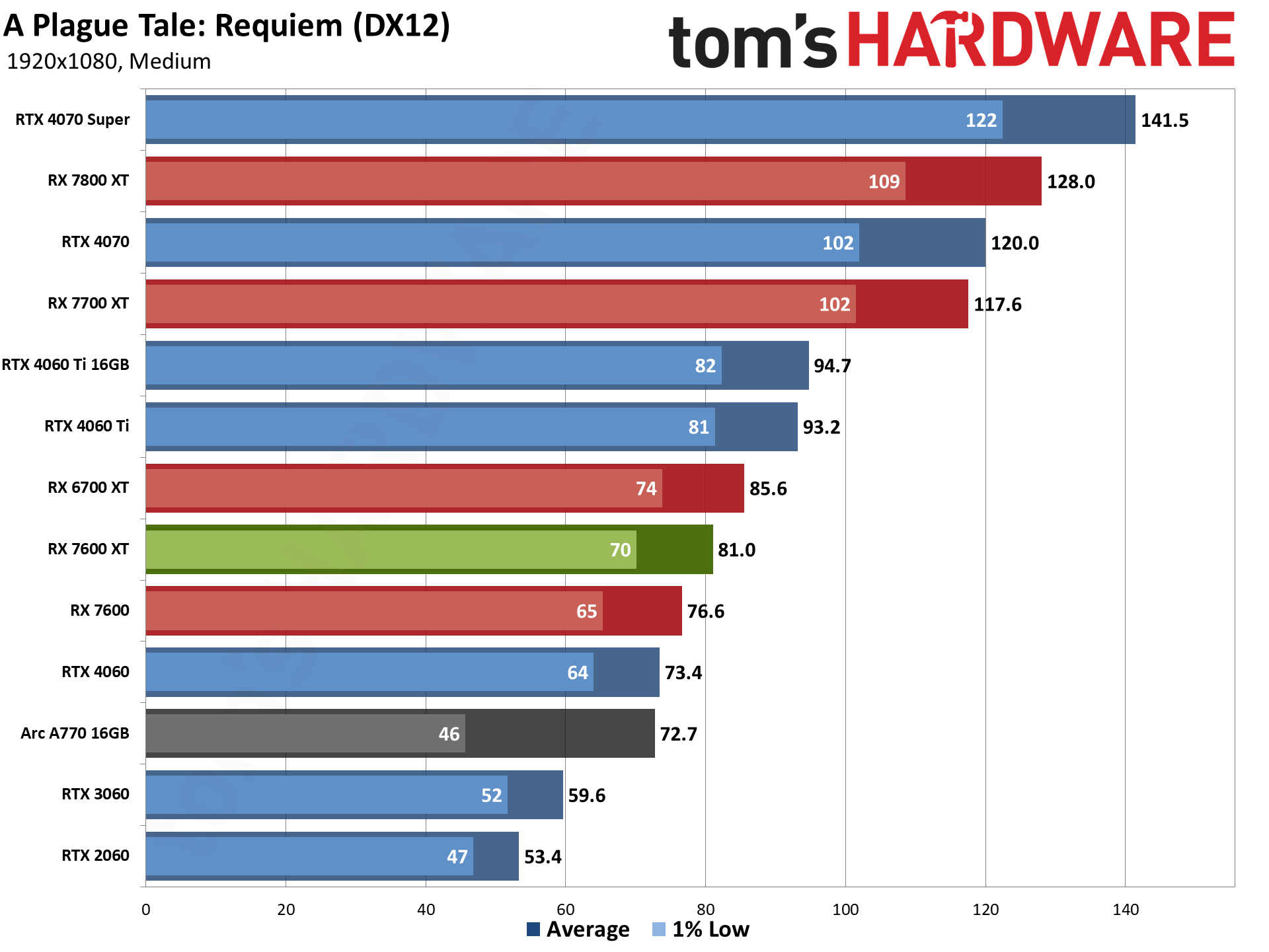
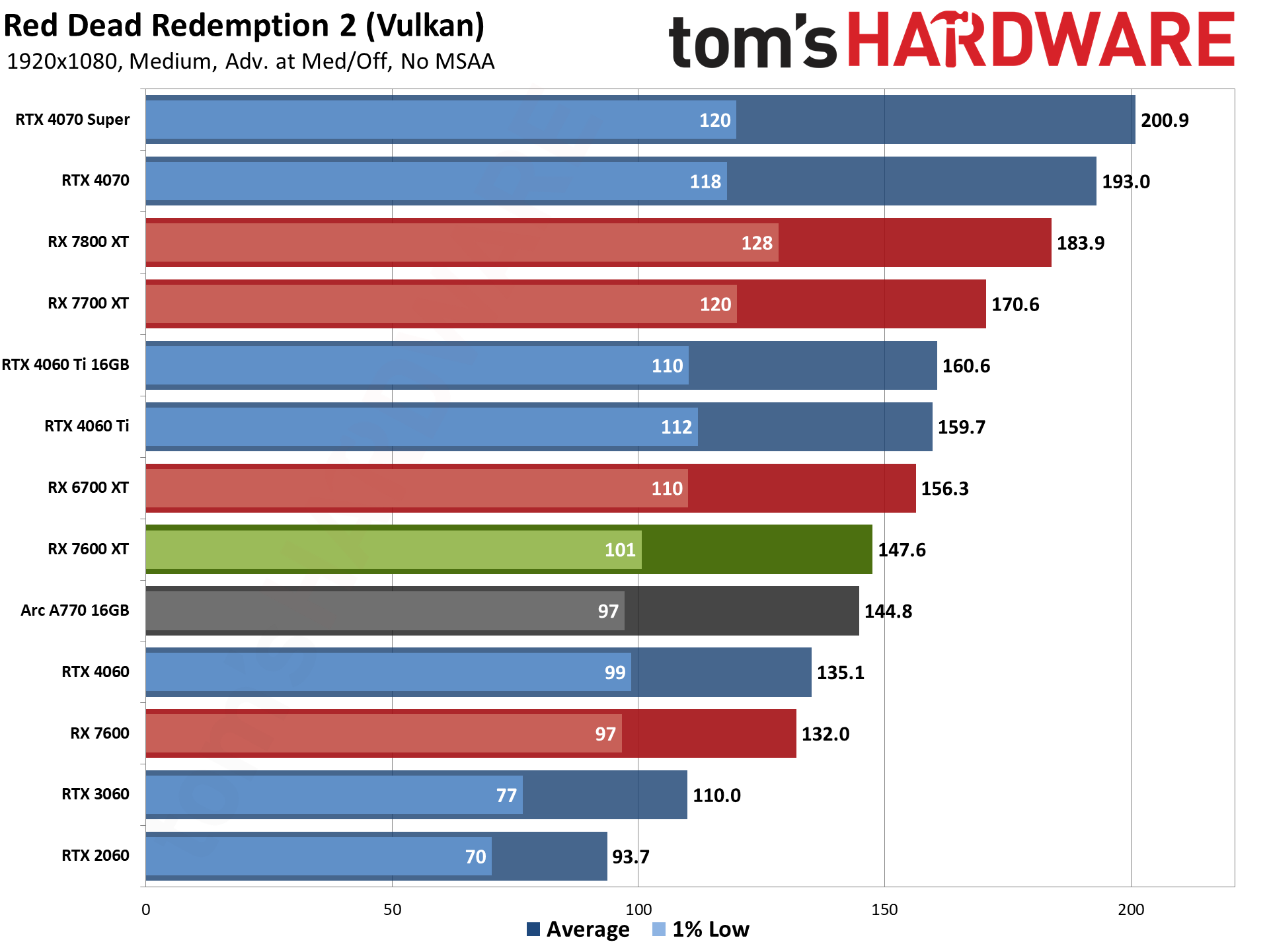


Switching to pure rasterization benchmarks, AMD's GPUs look significantly better, but that still doesn't radically change where the 7600 XT lands. It's again moderately faster than the vanilla 7600 — 9% at ultra settings, 5% at medium settings — and the RX 6700 XT in turn offers about 6% more performance. But it's also clearly ahead of the RTX 4060 now at least, though only by 5–6 percent.
The individual games show the usual range of improvements. Quite a few start to hit CPU bottlenecks at 1080p medium settings, so the 7600 XT only offers a few percent higher performance than the RX 7600, but at least it's never slower. Higher clocks and power gives it that benefit, even if shader counts remain unchanged. The one major outlier in our rasterization suite is Forza Horizon 5, which is known to exceed 8GB of VRAM use. As we saw with the RTX 4060 Ti 16GB, that means the extra memory helps a lot — 25% using the extreme preset.
Against the direct Nvidia competition, the RTX 4060, the only major loss comes in Total War: Warhammer 3. Conversely, Borderlands 3 greatly favors the AMD GPU, at least at the Badass preset. Or you could argue that the price starts to put it into competition with the RTX 4060 Ti, in which case Nvidia makes a clean sweep of the benchmarks, even with only 8GB of memory.
AMD RX 7600 XT 1080p Ray Tracing Performance

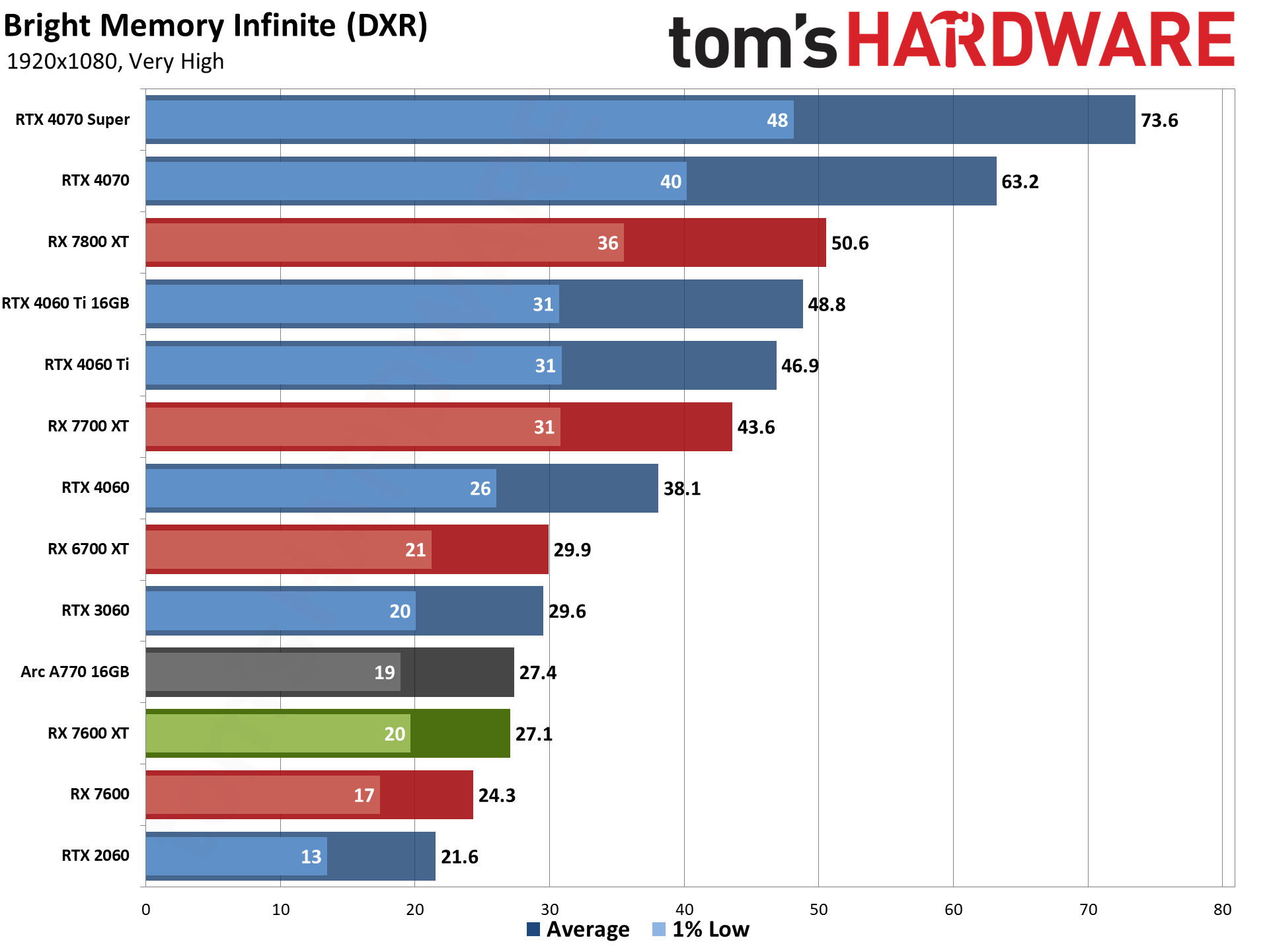
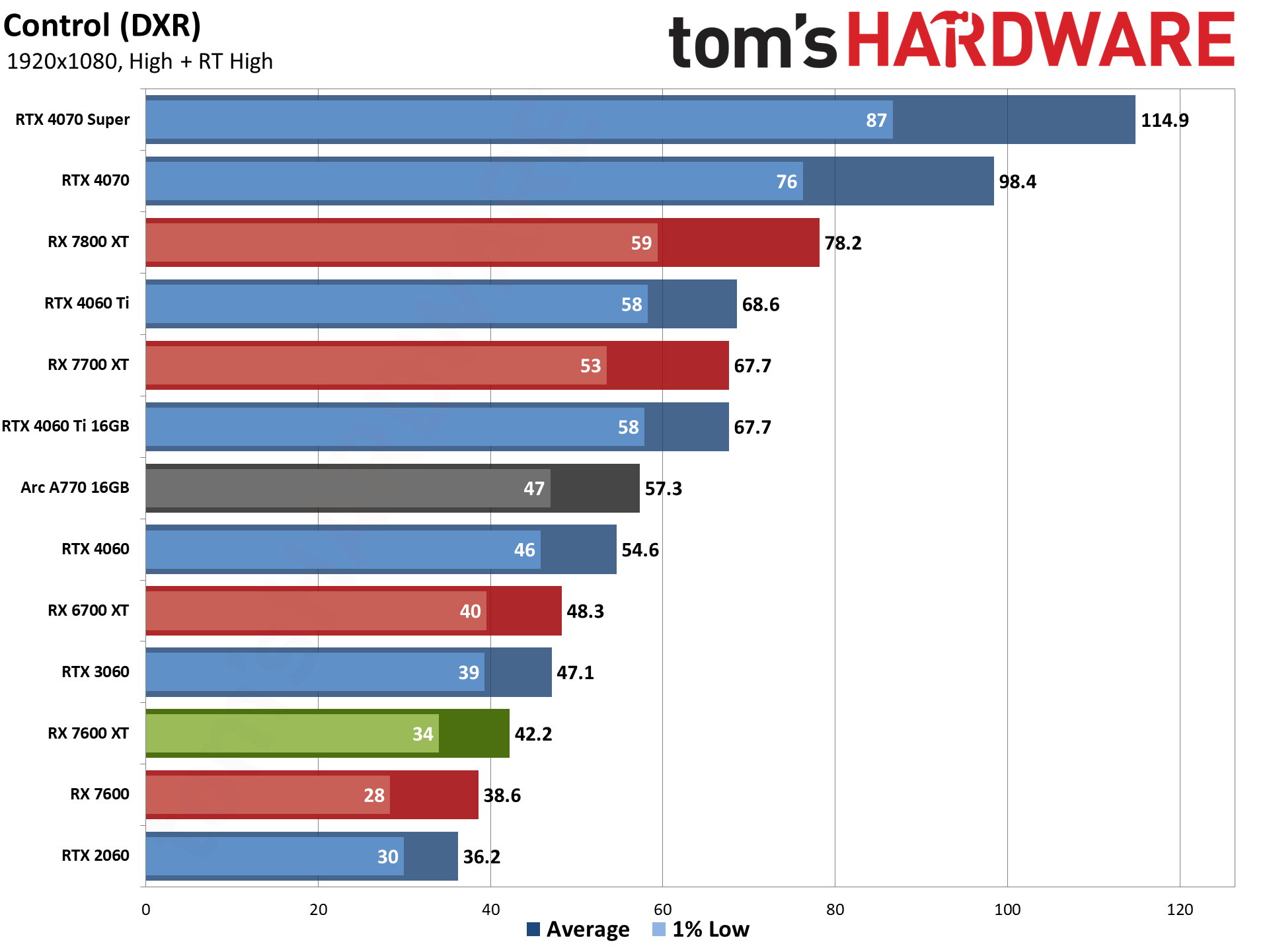
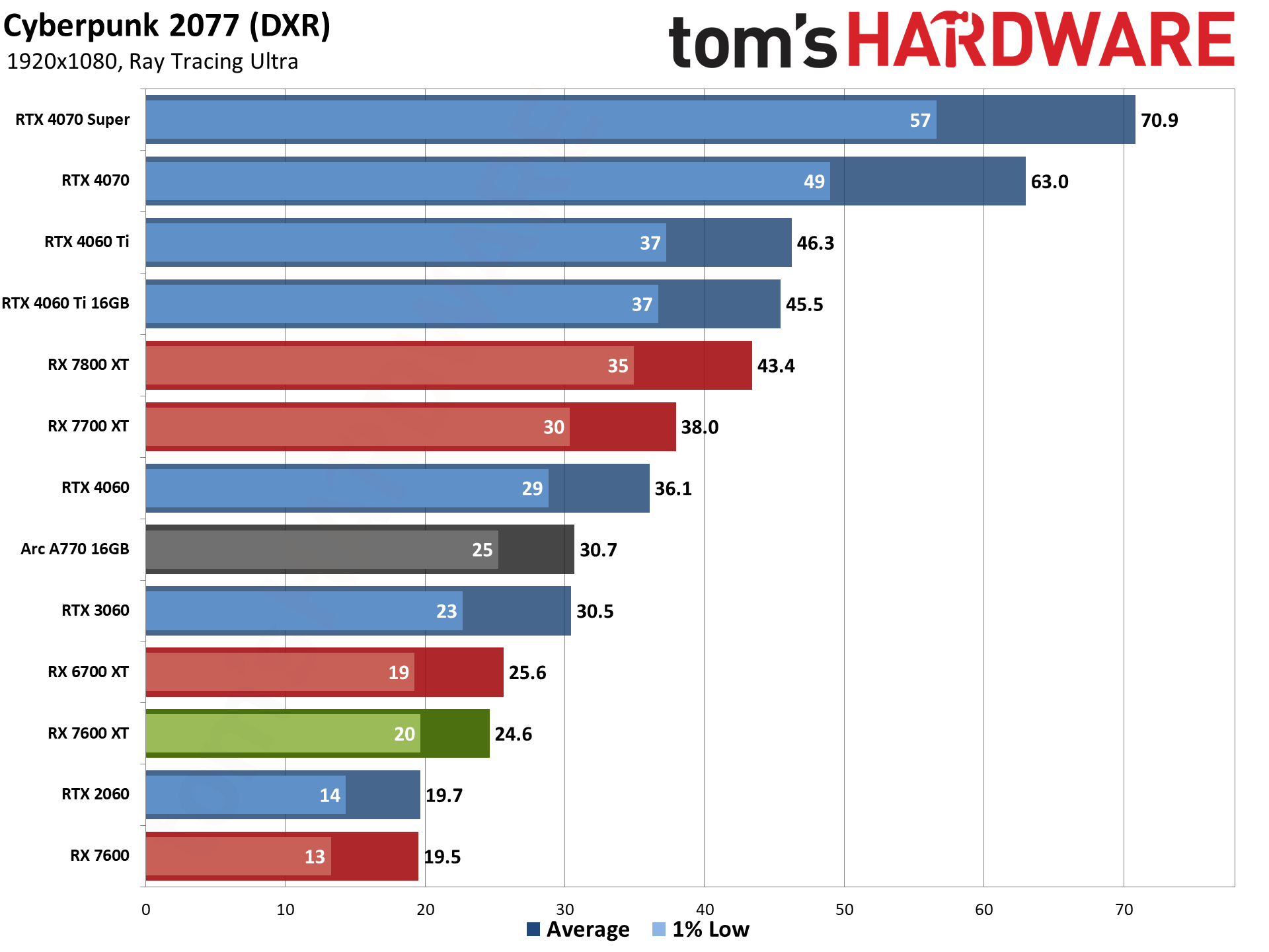


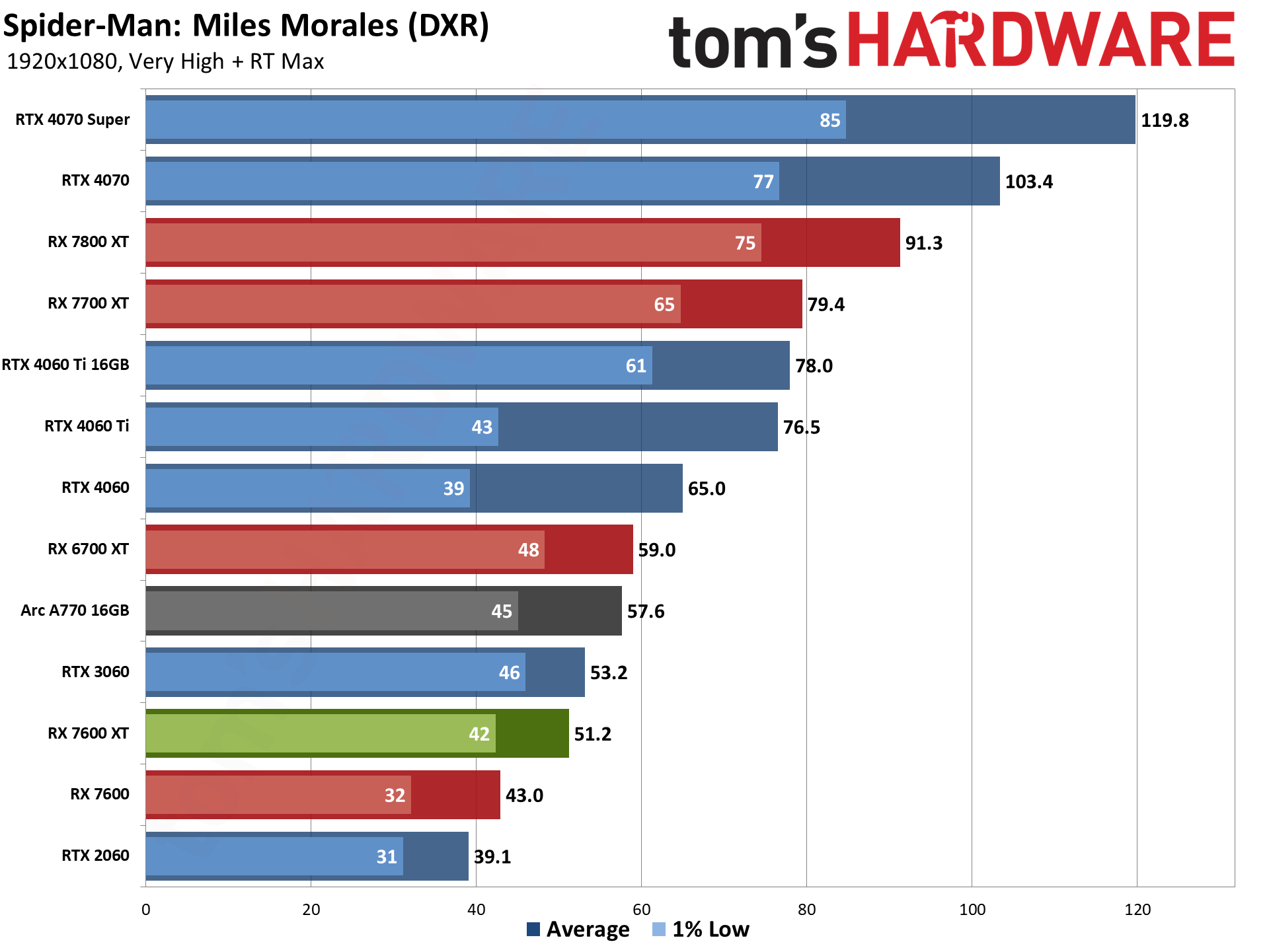
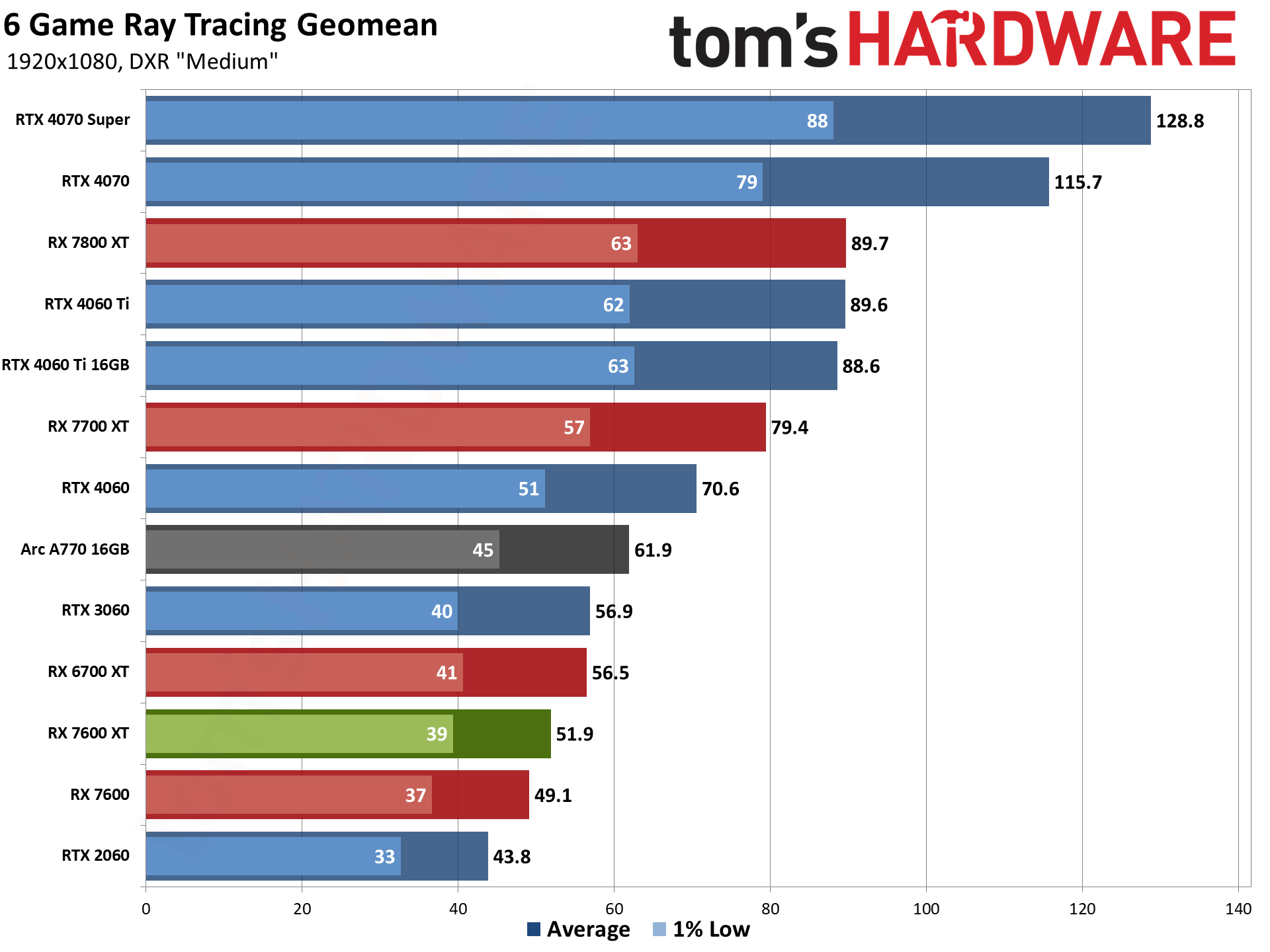
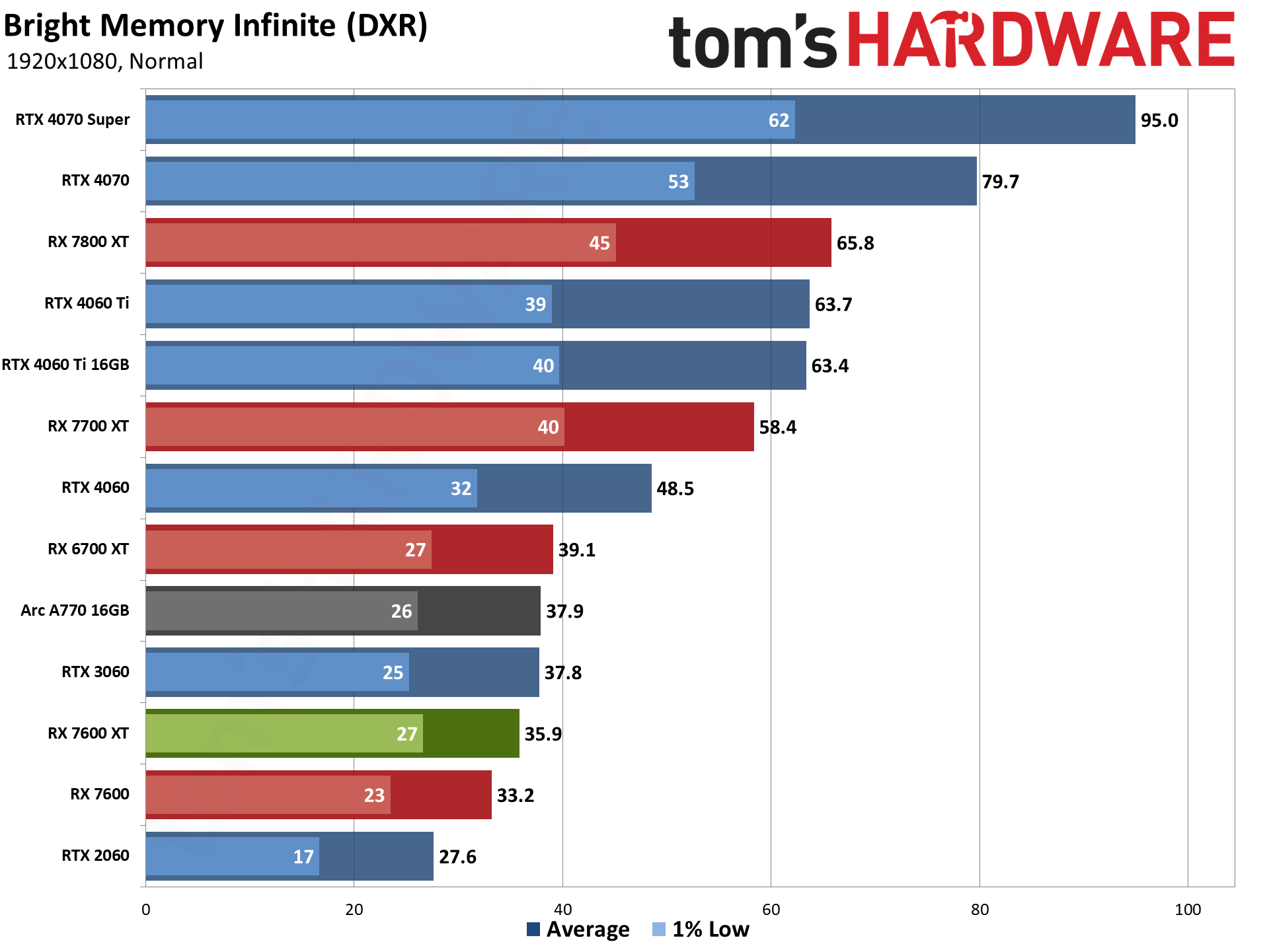
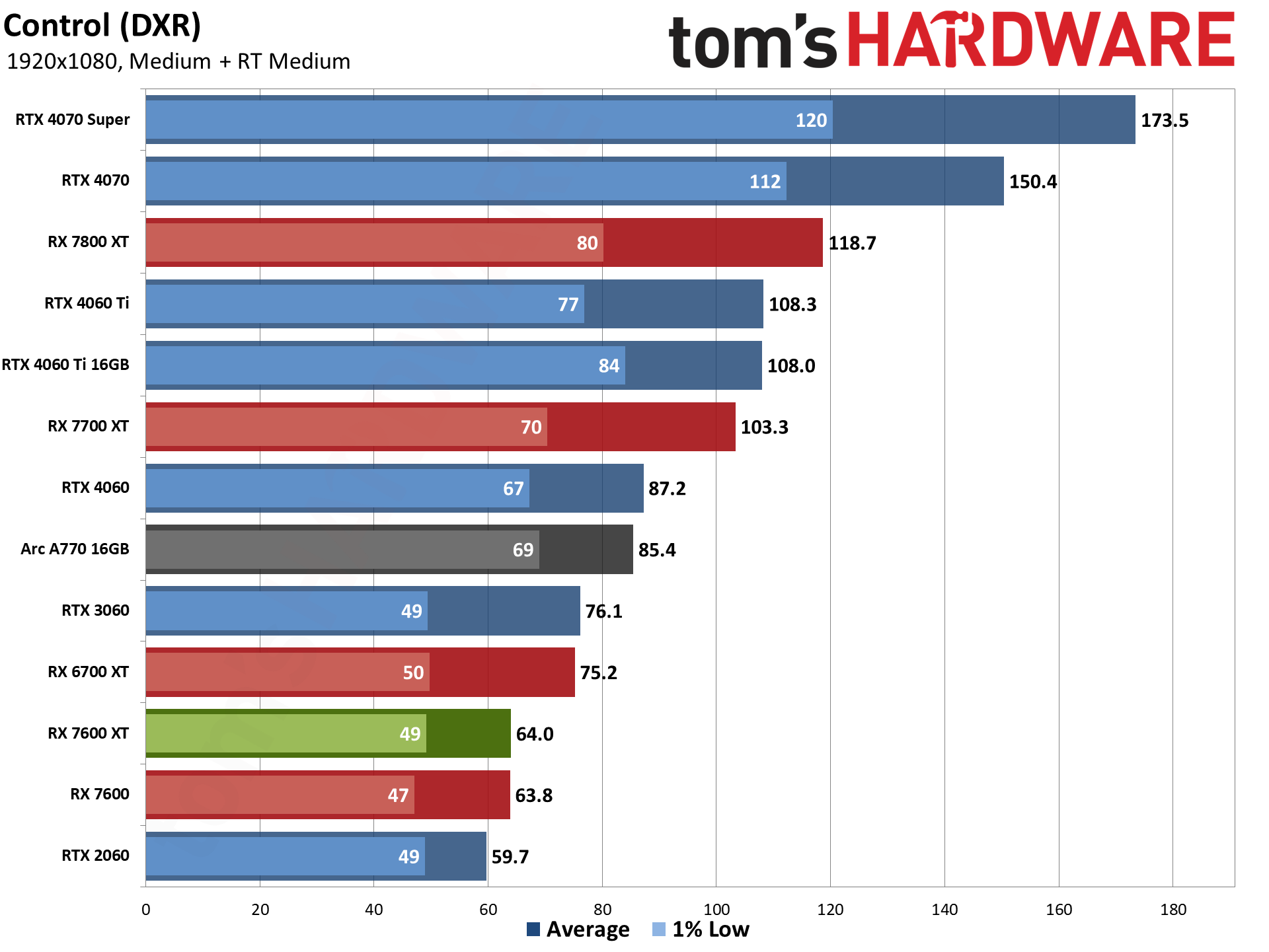
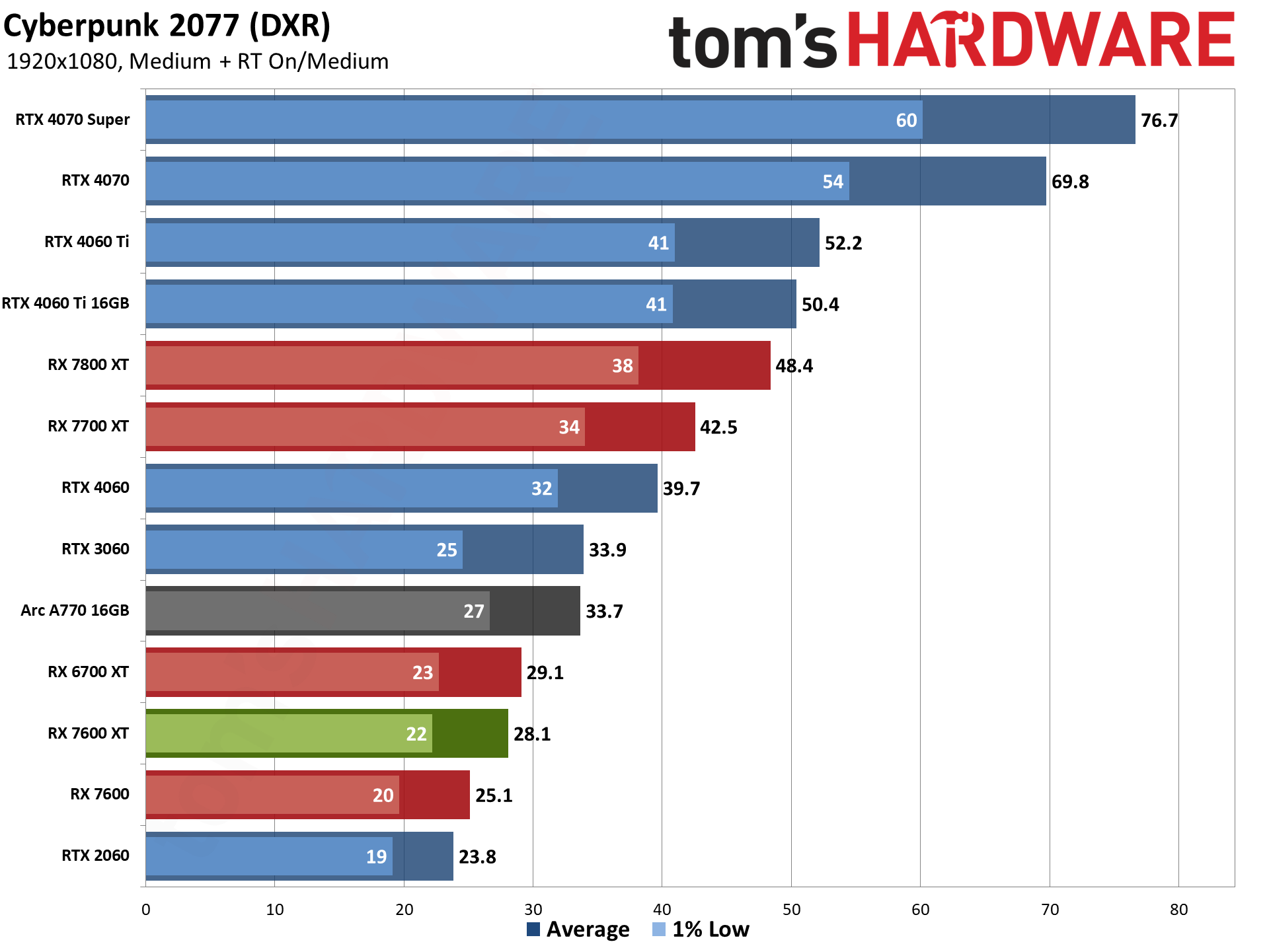


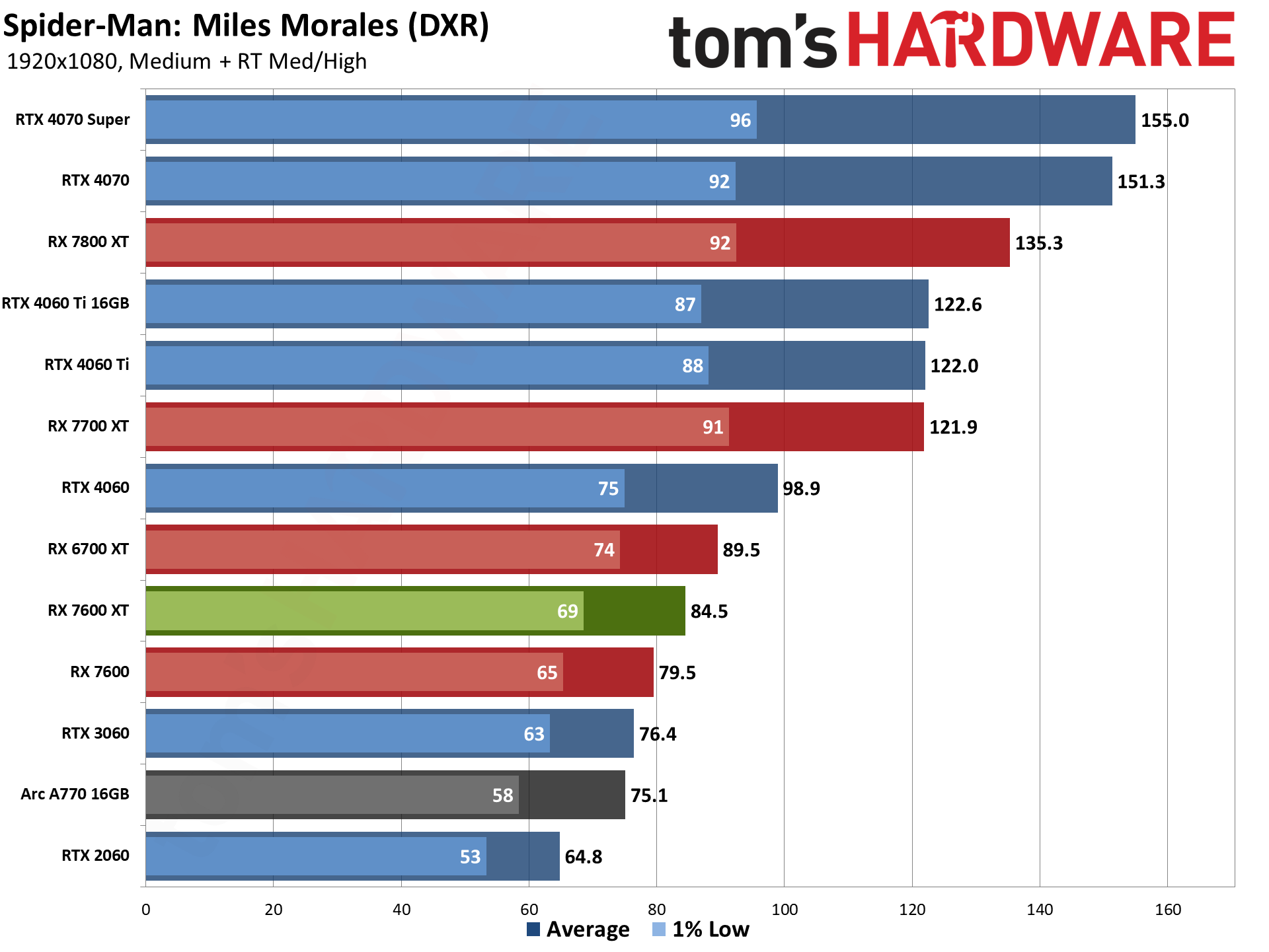
Ray tracing as usual proves to be the Achille's Heel of AMD GPUs. Where the 7600 XT beat the RTX 4060 in nearly every rasterization game we tested, the reverse is true with ray tracing. Overall, it's 27–28 percent slower than the RTX 4060 across the six games we tested, losing by a few percent in Metro, and 15–20 percent in Spider-Man. It trails by 23–32 percent in Bright Memory Infinite, Control, and Cyberpunk 2077, and then Minecraft as usual 'wins' for being the most demanding RT game in our standard test suite and the RX 7600 XT is only about half as fast as the RTX 4060.
Does ray tracing performance matter on a card that costs $300–$350? AMD might say no, but clearly the competition from Nvidia can put up far more reasonable numbers. Every game is playable with RT enabled on the 4060, even at ultra settings, and upscaling could push most games above 60 fps — for the those that aren't already there. Most of the games are generally at least playable on the 7600 XT as well, though a couple drop below 30 fps and would need upscaling just to reach playable status at 1080p.
The RX 6700 XT also does slightly better in the DXR tests, averaging 9–10 percent higher performance. So even against existing AMD GPUs, the 7600 XT and Navi 33 still fail to impress.
AMD RX 7600 XT 1080p Bonus Games
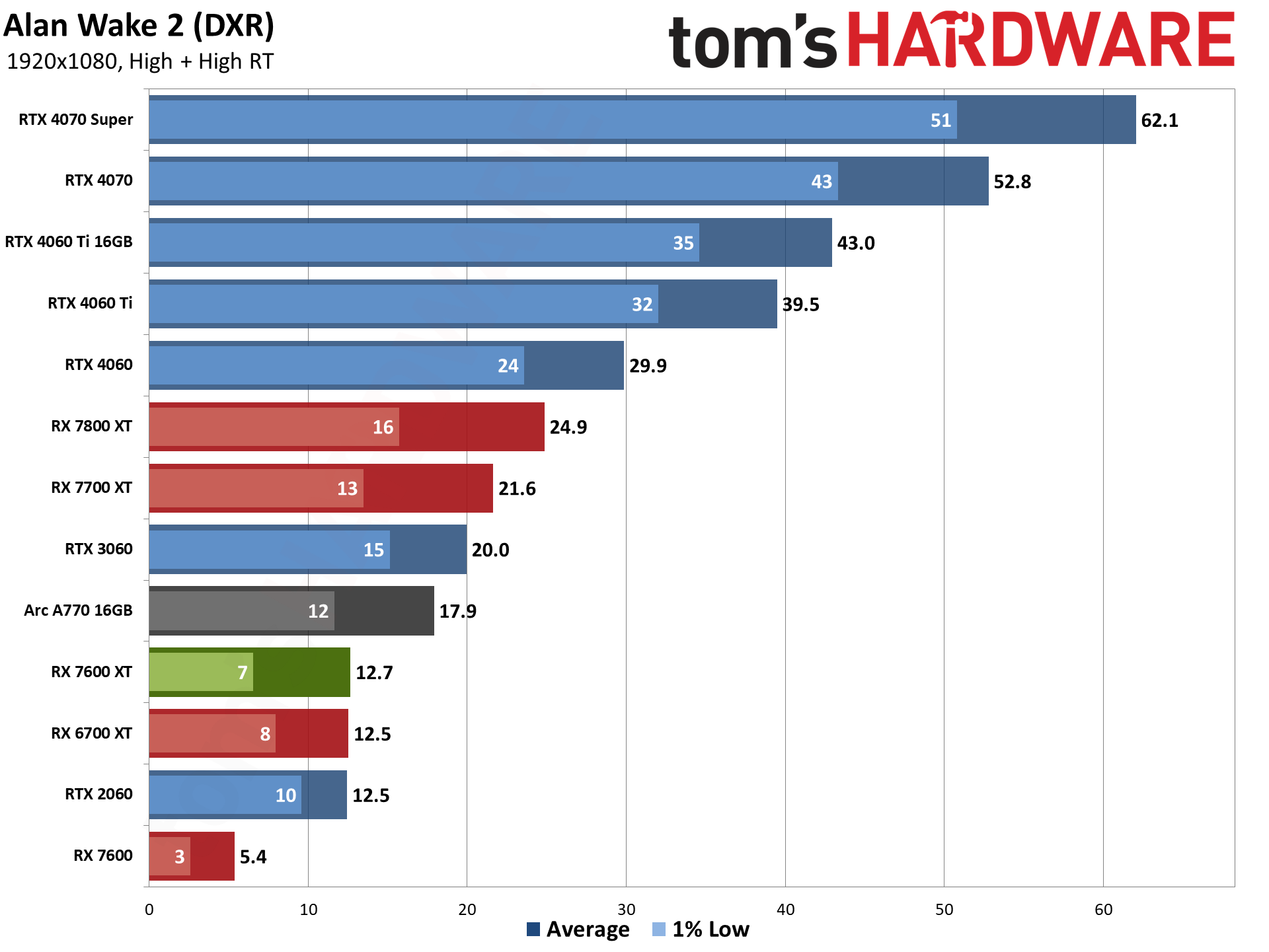
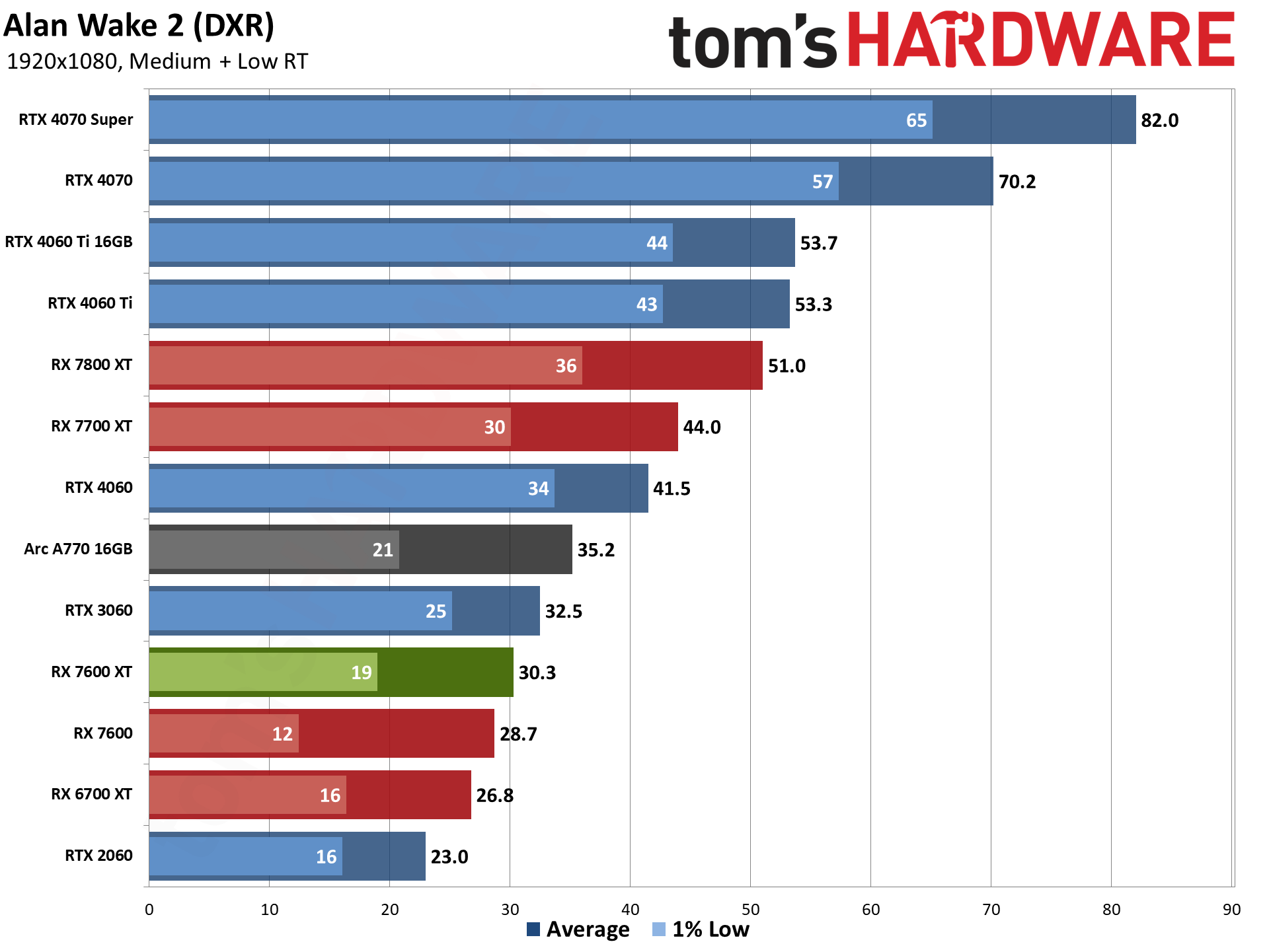

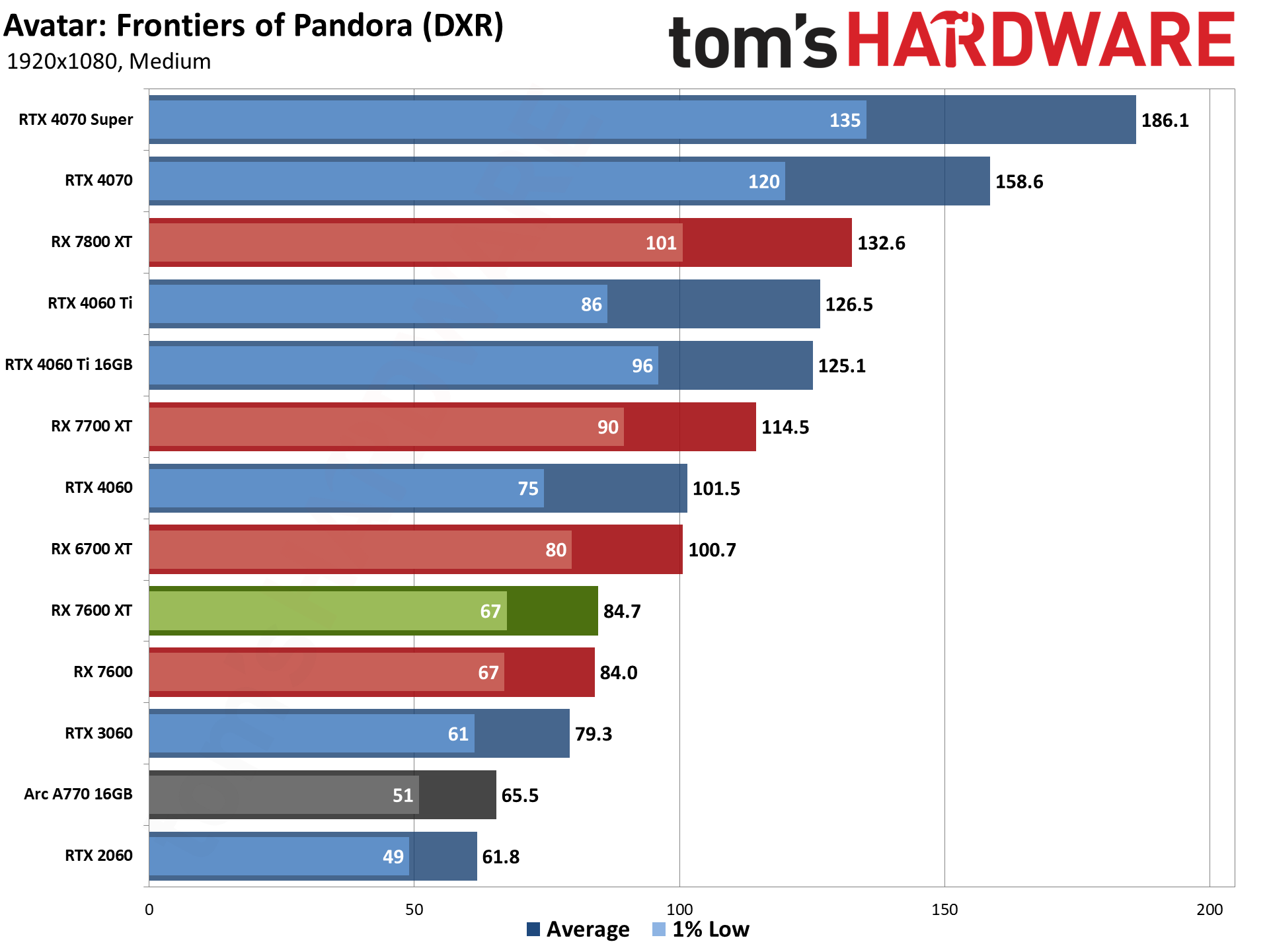

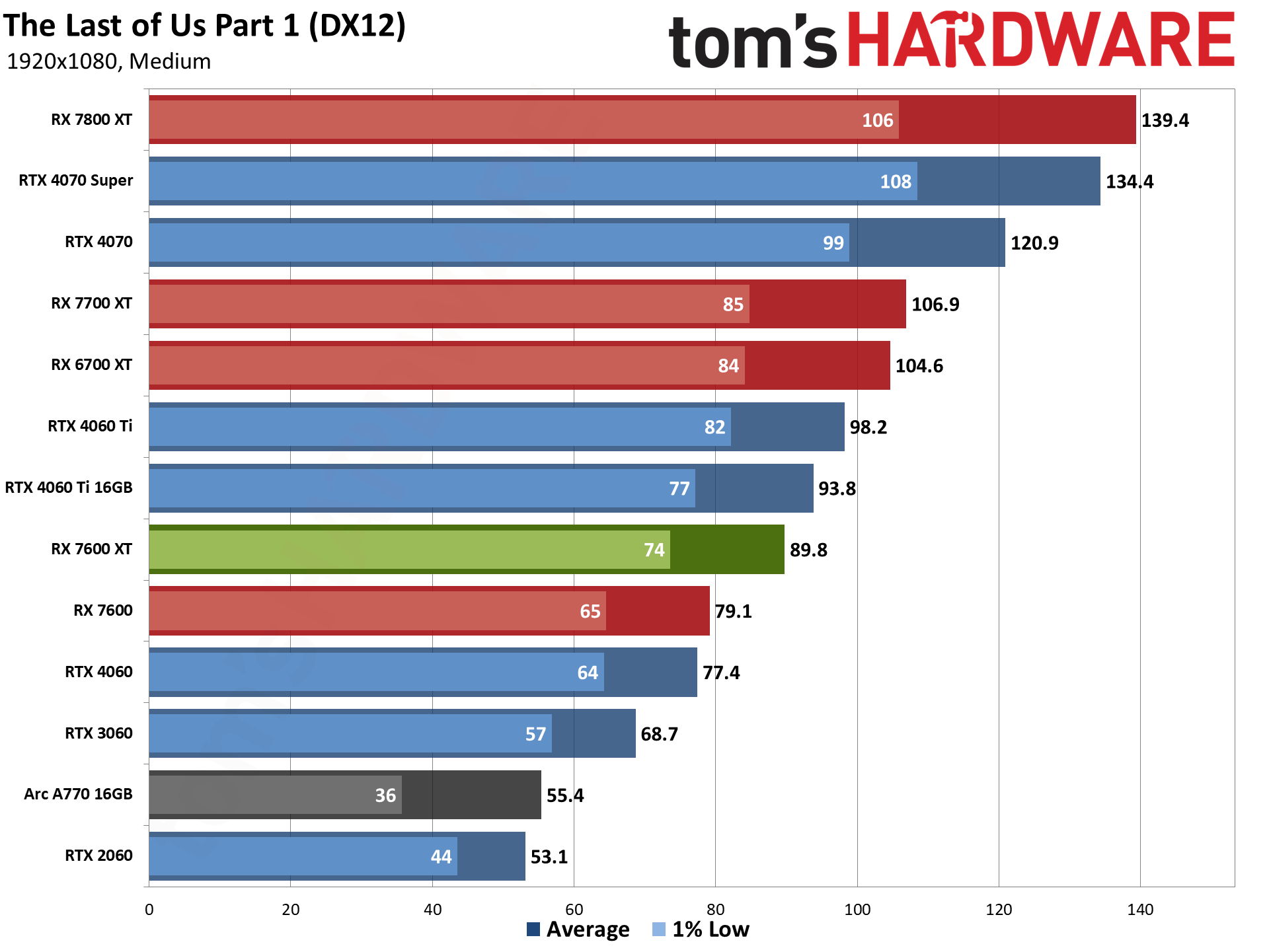
We've added three more recent games to our testing that tend to be more demanding than some of the older games in our suite. Alan Wake 2 is an Nvidia-promoted game that uses full path tracing (with "high" settings), while Avatar: Frontiers of Pandora and The Last of Us, Part 1 are AMD promoted games. We've enabled Quality mode upscaling in Alan Wake 2 and Avatar, with DLSS on Nvidia GPUs and FSR2/3 on AMD GPUs.
Alan Wake 2 barely manages to break 30 fps at medium settings with limited RT effects, and that's as far as you'd want to push mainstream AMD GPUs in the game. But just for kicks, we turned on full path tracing. 13 fps? Thanks, but no. The RTX 4060 can still get 30 fps at least, without enabling frame generation. Still, lower-end GPUs aren't going to want to use path tracing — even if this is one of the few cases where the 7600 XT can tie the 6700 XT.
Avatar still uses some RT effects, though they're far less noticeable in our experience. Also, it runs at much higher levels of performance on all of the GPUs, averaging over 60 fps on the 7600 XT even at ultra settings. Curiously, there's almost no difference between the 7600 and 7600 XT here, even though the XT should be clocking higher and thus allowing for at least a slight increase in performance.
The Last of Us definitely favors AMD's GPUs, and it can also push beyond 8GB of VRAM use at higher resolutions. The 7600 XT beats the 7600 by 10% at ultra settings and 14% at medium settings, which is more in line with what we see in other games. Both also outperform the RTX 4060 (barely in the case of the 8GB card).
- MORE: Best Graphics Cards
- MORE: GPU Benchmarks and Hierarchy
- MORE: All Graphics Content
Get Tom's Hardware's best news and in-depth reviews, straight to your inbox.
Current page: AMD RX 7600 XT: 1080p Gaming Performance
Prev Page AMD Radeon RX 7600 XT — Sapphire Pulse Next Page AMD RX 7600 XT: 1440p Gaming Performance
Jarred Walton is a senior editor at Tom's Hardware focusing on everything GPU. He has been working as a tech journalist since 2004, writing for AnandTech, Maximum PC, and PC Gamer. From the first S3 Virge '3D decelerators' to today's GPUs, Jarred keeps up with all the latest graphics trends and is the one to ask about game performance.
-
Roland Of Gilead AMD's version of the 4060ti! :rolleyes: Disappointing it comes behind even the Arc770.Reply -
btmedic04 This would have been a much more compelling product had it used a further cut down Navi 32 with 3x mcds, 12gb of vram and a $350ish price point. DisappointingReply -
King_V Reply
Well, AMD's version of the 4060ti 16GB, I would say... although, to be fair, it does give SOME performance benefit over the 7600 non-XT. The 4060 Ti 16GB gave just about nothing over the 4060 Ti 8GB (for gaming purposes, an edge case or two notwithstanding)Roland Of Gilead said:AMD's version of the 4060ti! :rolleyes: Disappointing it comes behind even the Arc770. -
JarredWaltonGPU Reply
I do wonder if AMD may eventually try doing an RX 7700 non-XT with those specs, but realistically I think the total cost of 3xMCD plus the Navi 32 GCD means making such a card and selling it at $350 is a losing proposition.btmedic04 said:This would have been a much more compelling product had it used a further cut down Navi 32 with 3x mcds, 12gb of vram and a $350ish price point. Disappointing -
btmedic04 Reply
Yeah, it's more than likely too expensive to hit a $350 price point and still have any kind of profit margin. One can still dream at least lol.JarredWaltonGPU said:I do wonder if AMD may eventually try doing an RX 7700 non-XT with those specs, but realistically I think the total cost of 3xMCD plus the Navi 32 GCD means making such a card and selling it at $350 is a losing proposition. -
Roland Of Gilead Reply
TrueKing_V said:Well, AMD's version of the 4060ti 16GB, I would say... although, to be fair, it does give SOME performance benefit over the 7600 non-XT. The 4060 Ti 16GB gave just about nothing over the 4060 Ti 8GB (for gaming purposes, an edge case or two notwithstanding) -
usertests +$60 is not a huge premium over the 7600 for the extra memory, but the 7600 is overpriced in the first place.Reply
It's not much slower than the 6700 XT, but the 6700 XT is clearly better and 12 GB VRAM is fine. If you want the 7600 XT to play with AI, good luck.
Get it down to $270-280, what the 6700 10 GB used to cost, and it looks more interesting. Although 6700 XT was as low as $295-300 (new) in Nov-Dec. Something tells me they will run out before they return to that price point.
